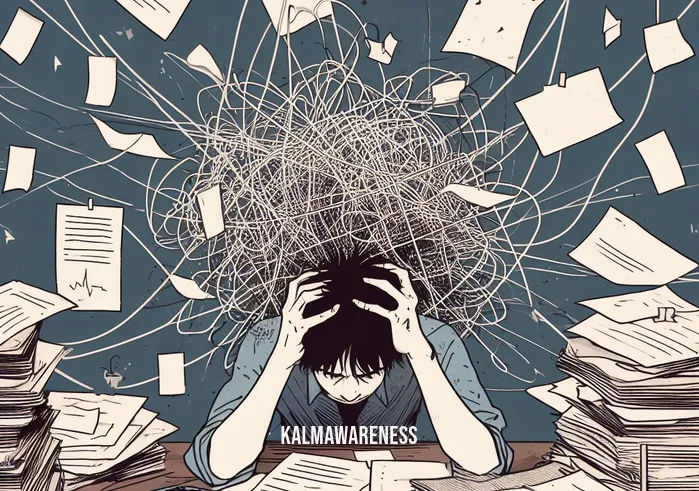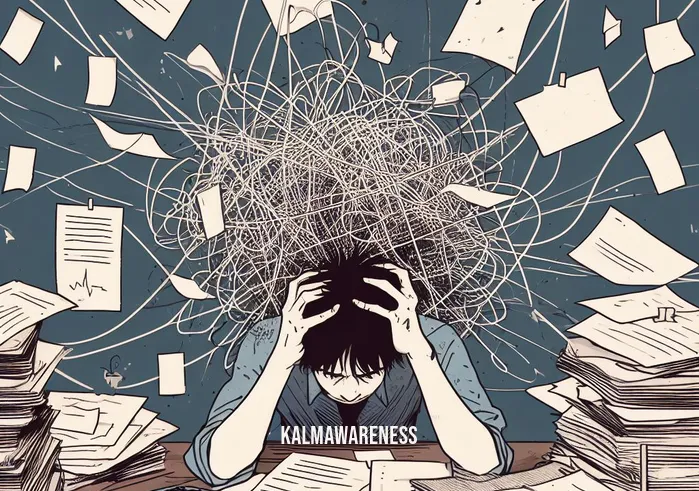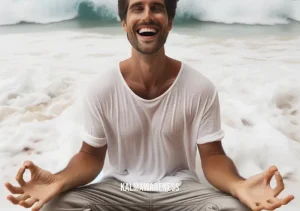Keep Calm and Think Strait: Embracing Mindfulness and Meditation
In today’s bustling world, the phrase “keep calm and think strait” resonates profoundly with many. It signifies the necessity to maintain a balanced mindset amid life’s chaos. A journey into mindfulness and meditation offers tools and practices that foster such mental clarity. As we delve into the realms of mindful movement for sleep, hypnobirthing, and the teachings of Jack Kornfield for beginners, we understand the nuances that anchor one’s mind and maintain focus. In this introductory segment, we set the foundation for embracing these practices, comprehending their significance, and embarking on a transformative journey.
The Essence of Mindfulness and Meditation
Mindfulness, often interchanged with meditation, is a practice rooted in ancient traditions. While meditation refers to a broader range of practices, mindfulness is a form of meditation that involves attaining a peaceful state of mind wherein thoughts aren’t occupied by worry. The core of these practices centers on achieving mental clarity, combating stress, and channeling focus. Whether you’re practicing yoga in the serene corners of your home or visiting Buddhist temples in Kansas City, the essence remains: be present, be observant, be calm.
Navigating Stress in Modern Times
Modern life, with its myriad challenges, often leaves individuals grappling with anxiety, tension, and restlessness. This reality makes phrases like “keep calm and think strait” not merely words, but a meaningful reminder to reclaim mental tranquility. Whether you’re a teenager walking through the tumultuous phase of adolescence or an adult juggling work and home, the principles of mindfulness serve as a beacon.
Techniques and Practices: An Overview
For those new to the domain, starting can seem overwhelming. Yet, with guides like Meditation Made Simple and resources that teach how to stabilize one’s mind, the journey becomes more navigable. While some might find solace in lying down meditations, others might resonate with practices that involve more physical engagement, like mindful movements or exercises that integrate an element of deep focus.
Mindfulness Beyond the Mat
While meditation and mindfulness are often associated with dedicated sessions, their principles permeate daily life. It could be as simple as observing one’s thoughts without judgment, a practice reminiscent of the judgment of the wise. Or it could manifest in routines, where individuals partake in sustainable self-care, reminding themselves daily of the blessings, possibly with practices like one for each blessed day.
Setting the Stage for Deeper Exploration
As we delve deeper into the world of mindfulness and meditation, we will unearth practices, philosophies, and techniques that promise mental clarity, focus, and calmness. While this segment has provided a comprehensive overview, the subsequent chapters will dissect each facet in detail, from understanding the nuances of touching specific body parts during meditation to exploring the profound depths of how and why we can achieve deep mental states so swiftly.
As we journey together, remember the core mantra: “keep calm and think strait.” The path might seem arduous, but with each step, the fog clears, revealing a world of tranquility and understanding. Let’s embark on this enlightening journey together. Continue reading in the next segment for a deep dive into each technique, practice, and the transformative power of mindfulness.

Navigating Mental Pathways: The Nuances of “Keep Calm and Think Strait”
As we traverse the vast landscapes of mindfulness and meditation, the guiding principle “keep calm and think strait” shines as a beacon, directing us toward mental harmony. While the initial chapter provided a comprehensive introduction, let’s delve into specific techniques and methodologies that help maintain a calm demeanor and clear thinking, especially in tumultuous times.
Understanding the Layers of Calmness
Calmness isn’t merely the absence of chaos; it’s a state of being. And to truly embrace it, we must understand its layers:
Surface Calmness: Achieved by avoiding immediate stressors, akin to taking a break from work or engaging in a hobby. A practice illustrated by mindful movement for sleep.
Emotional Calmness: Engaging with our emotions without getting swept away. As we touch that body part in meditation, we form a tangible connection with our emotional states.
Deep-rooted Calmness: Cultivating a mindset that remains undeterred regardless of external circumstances. Practices that foster such a state include deep meditation sessions or visiting places that promote inner peace, such as Buddhist temples in Kansas City.
Techniques to Enhance Mental Clarity
Mental clarity is the ability to think strait, free from distractions. To attain this, one can:
Body Awareness Meditation: Ground yourself by concentrating on specific parts of your body. It fosters mindfulness and enhances connection with oneself. The philosophy behind “I am not the body; I am not even the mind” expands on this.
Deep Breathing Exercises: They serve as an anchor, helping drift away from overwhelming thoughts. One can further explore the role of breathing in Jack Kornfield’s meditation for beginners.
Structured Thought Processes: Instead of allowing the mind to wander, channel thoughts in a constructive manner. Techniques that teach how to spell stabilize enhance this practice.
Tools to Aid in the Journey
A structured approach, facilitated by the right tools, can make the journey smoother. Here’s an illustrative table to guide your quest:
| Tool | Purpose | Source |
|---|---|---|
| Guided Meditation Apps | Provide structured meditation sessions tailored for various needs. | Meditation Made Simple |
| Dedicated Meditation Spaces | Offer a sanctuary free from distractions, enhancing the meditation experience. | Buddhist temples in Kansas City |
| Informative Literature | Grants deeper insights into practices, techniques, and their benefits. | Jack Kornfield’s meditation for beginners |
| Mindfulness Reminders | Gentle nudges, perhaps in the form of apps or journals, to practice mindfulness daily. | One for each blessed day |
| Community or Group Sessions | Engage in collective meditation, harnessing group energy and learning from peers. | Sustainable self-care |
The Road Ahead
As we journey further into the intricacies of “keep calm and think strait,” understanding its layers, and exploring techniques and tools that aid in its realization, we lay the groundwork for a serene mind and focused thoughts. The transformative power of these practices transcends beyond the realm of meditation, influencing every facet of our lives.
In the next chapter, we’ll dive into the experiential aspect, understanding real-life accounts and narratives that showcase the profound impacts of embracing calmness and clarity. Let this journey guide you, enlighten you, and help you navigate life’s tumult with a poised heart and a lucid mind. Continue reading to immerse yourself deeper.

Echoes of Serenity: Inspirational Tales of “Keep Calm and Think Strait”
Amid the cacophony of modern life, the mantra “keep calm and think strait” emerges as a guiding light for many. Its essence isn’t confined to meditation mats or tranquil retreats. Instead, its impact resonates in real-world scenarios, echoing hope, resilience, and the power of inner calm. This chapter unfolds the inspirational tales of individuals who, through their commitment to mental clarity and tranquility, have transformed challenges into opportunities, reminding us that serenity is a choice.
Sarah’s Journey: From Chaos to Calm
Sarah, a dedicated mother and a relentless professional, found herself amid the whirlwind of life’s demands. Exhaustion, stress, and a ceaseless to-do list clouded her days until she discovered the transformative power of mindful hypnobirthing. Embracing the philosophy of “keep calm and think strait,” Sarah found solace in moments of stillness, leading to enhanced focus in her daily tasks and a harmonious work-life balance.
The Enlightening Words
Words possess the power to heal, inspire, and reframe perspectives. And in our quest for tranquility and clarity, they play a pivotal role.
“In the middle of every difficulty lies opportunity.” – Albert Einstein
This quote emphasizes the essence of viewing challenges not as setbacks but as opportunities to grow, learn, and, most importantly, to remain calm.
“Peace comes from within. Do not seek it without.” – Buddha
Echoing the teachings from Buddhist temples in Kansas City, this quote resonates with the philosophy of finding serenity within oneself, underlining the importance of inner calm.
“To understand the immeasurable, the mind must be extraordinarily quiet, still.” – Jiddu Krishnamurti
Reinforcing the idea behind mindfulness being the key to happiness now, Krishnamurti’s words urge us to cultivate a still mind to comprehend life’s vastness.
Jake’s Story: Gaining Clarity Amidst Uncertainty
Jake’s life took an unexpected turn when he faced a career setback. Instead of succumbing to despair, he turned to the principles of “keep calm and think strait.” Engaging in practices that involve attaining a peaceful state of mind, Jake rediscovered his passion and purpose, ultimately steering his career in a direction aligned with his authentic self.
The Ripples of Impact
While Sarah and Jake’s stories illuminate the transformative power of mental clarity and calmness, countless others across the globe find solace in this philosophy. From professionals battling burnout to students navigating academic pressures, the practice’s ripples of impact are profound. Judgment of the wise has it that such stories serve as a testament to the age-old wisdom of inner peace as the key to outer success.
Venturing Into The Unknown
As we delve deeper into the essence of “keep calm and think strait,” it’s pivotal to remember that this journey isn’t a destination but a continuous process. Life will invariably present challenges, but armed with the right mindset, tools, and inspiration, navigating these tumultuous waters becomes a transformative experience.
In the next chapter, we will explore the scientific underpinnings of why these practices work, understanding the intricate dance between the mind, body, and spirit. If tales of hope and transformation have inspired you, the science behind them will surely intrigue. Continue reading to merge the realms of inspiration and information, uncovering deeper layers of “keep calm and think strait.”

Unraveling Tranquility: The Mechanics of “Keep Calm and Think Strait”
Diving deeper into the philosophy of “keep calm and think strait,” we discover that its simplicity masks a plethora of intricate mechanics. While stories of transformation inspire and quotes ignite passion, a thorough understanding of the underlying principles can empower us even more. This chapter seeks to decode the foundations of this philosophy, breaking down its elements for a clearer grasp.
Core Principles of “Keep Calm and Think Strait”
Understanding the philosophy’s foundational principles offers insights into its profound impact:
Presence Over Past or Future: Being in the present moment. Rather than dwelling on the past or fretting about the future, one embraces the ‘now.’ This tenet aligns with practices from mindful movement for sleep, where the focus is purely on the current moment.
Acceptance Over Resistance: Embracing situations as they come, without the need to control or change them. This acceptance doesn’t mean passivity, but rather a conscious choice to refrain from needless resistance.
Observation Without Judgment: Observing thoughts and emotions without labeling them as ‘good’ or ‘bad.’ This principle mirrors the judgment of the wise, where wisdom lies in pure observation.
Techniques that Foster Calm and Clarity
Harnessing tranquility and clarity isn’t elusive; it’s anchored in specific practices:
Breathing Exercises: Breath, the life force, is a powerful tool. Techniques like deep belly breathing or alternate nostril breathing foster calmness.
Visualization: Imagining a serene place or situation can transport the mind to a state of calm. A practice that involves attaining a peaceful state of mind.
Mindful Activities: Engaging in activities with full attention, be it walking, eating, or even mundane tasks, turns them into meditative practices.
Guided Meditations: For those who find it challenging to meditate independently, guided sessions, like the ones in Meditation Made Simple, can be beneficial.
Real-Life Applications of “Keep Calm and Think Strait”
Decision Making: A calm mind evaluates options more rationally, leading to better decisions.
Conflict Resolution: Approaching conflicts with clarity can lead to more constructive solutions.
Creativity Boost: A serene mind is a fertile ground for creative ideas, as it isn’t clouded by stress or anxiety.
Enhanced Productivity: With a clear focus, tasks are executed more efficiently, enhancing overall productivity.
Emotional Well-being: Embracing this philosophy fosters emotional resilience, reducing susceptibility to mental health challenges.
Bridging the Gap: Science and Spirituality
While the tales of transformation and the rich philosophical backdrop intrigue many, skeptics often seek a scientific basis. In our final chapter, we’ll delve into the empirical evidence supporting “keep calm and think strait.” How does the brain respond to these practices? What physiological changes ensue? Join us in the next chapter as we blend spirituality with science, offering a holistic perspective on the power of calm and clarity. Continue reading to witness the harmonious union of heart and mind.

Reflecting on the Journey: The Essence of “Keep Calm and Think Strait”
Our expedition into the realms of “keep calm and think strait” has been nothing short of transformative. From tales of hope to the meticulous breakdown of techniques, we’ve navigated through the vast landscapes of mindfulness, grounding ourselves in the profound wisdom of serenity and clarity. As we conclude this chapter, let’s revisit the profound insights and lessons we’ve imbibed, and more importantly, how to apply them in our daily tapestry of life.
Recapping the Pillars
Mindfulness & Meditation: From exploring mindful movement for sleep to the depths of Buddhist teachings, we’ve recognized that being present and immersed in the moment is pivotal.
Inspirational Narratives: Real-life accounts of Sarah and Jake served as testament to the transformative power of maintaining a calm demeanor and clear thought process even amidst life’s tempests.
Breaking Down Complexity: Through structured lists and comprehensive breakdowns, we delved into the mechanics of our guiding principle, understanding its nuances and real-world applications.
Embracing Tranquility in Daily Life
The teachings and wisdom aren’t merely confined to pages or meditation sessions; they beckon to be integrated into our daily lives. Whether it’s approaching challenges with a grounded mindset, making decisions with clarity, or simply pausing to breathe amidst a hectic day, “keep calm and think strait” serves as a gentle reminder and guiding light.
A Call to Dive Deeper
Our journey doesn’t end here. The world of mindfulness, serenity, and focus is vast and ever-evolving. To further your understanding and continue this journey:
Explore articles on how deep focus can lead to swift solutions.
Engage with our community sessions that promote sustainable self-care.
Delve into a structured approach to mindfulness with Meditation Made Simple.
A Note of Gratitude
Thank you, dear readers, for embarking on this journey with us. Your time, engagement, and keen interest in embracing tranquility have made this exploration immensely rewarding. As we wrap up this chapter, always remember the words of Lao Tzu, “At the center of your being, you have the answer; you know who you are and you know what you want.”
Stay curious, stay calm, and remember to think strait. We’re excited to continue offering more insightful content in our future editions. Until then, reflect, breathe, and embrace the profound beauty of the present moment.





